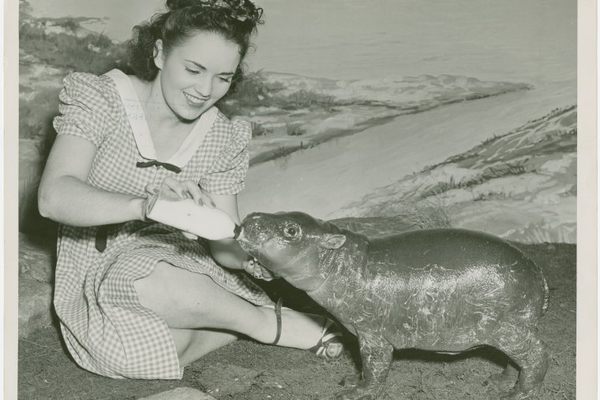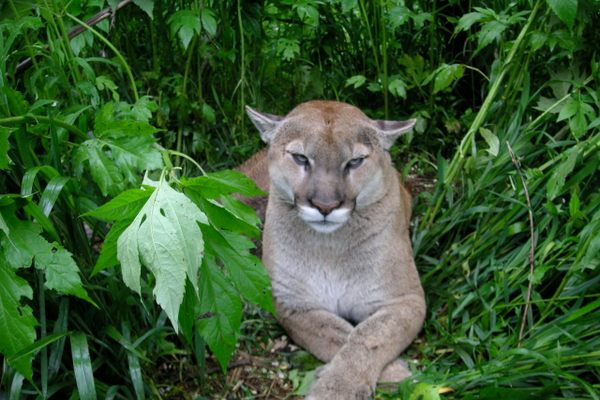The Story Behind the Most Famous Photo from Hurricane Andrew
How do you keep a flamingo flock safe in a major storm?
Miami Metrozoo flamingos, riding out Hurricane Andrew. (Photo: Copyright Ron Magill)
Hurricane preparedness is a tough job. This past weekend, many Americans got ready for Hermine, securing their outdoor furniture, boarding up their windows, and re-upping on batteries and bottled water.
But odds are that very few people had to stuff 30 flamingos in the bathroom of the Miami Metrozoo.

Back in 1992, in the leadup to Hurricane Andrew, Ron Magill of Miami, Florida found himself with two to-do lists. First, he had to prep his own home, where he and his wife (who was eight months pregnant) would ride out the storm together. Second, he had to help get an entire zoo ready for disaster.
Magill, then the zoo’s assistant curator, was skeptical. He had been working there for 12 years, and all the past hurricane threats—Alberto, Bob, Floyd—had come to nothing. When Andrew suddenly loomed, “I’m thinking to myself, my gosh, this is garbage,” he says now. “I thought we were doing all this for nothing.” But he and his team ran around doing what they could, making sure all of their furry, feathery and scaly charges were securely housed and fed.
Some of the bird exhibits weren’t likely to live up to the task. Most days, the flamingos loved being outside, sunning themselves in their outdoor lake. But a Category 5 storm promised to be somewhat less relaxing. As soon as they were sure Andrew would make landfall, Magill and the other keepers looked for somewhere else to put them.
The bathroom was the obvious choice—no windows, a tile floor for easy cleanup, and plenty of room for an improvised bed, made out of hay hastily dumped all over the floor. Most importantly, Magill adds, “it had a ready-made supply of fresh water.” He and his coworkers opened up all the stalls, made sure the toilets were full, and set out for the flamingo exhibit to grab the new tenants.
The birds were not very cooperative. “These flamingos are flapping everywhere, we’re grabbing them, we’re getting full of flamingo water and stuff,” says Magill. “It got to the point, I’ve got to be honest—I thought, ‘After all this work, this storm better freaking come!’ That’s a cocky young attitude that you have.”

Magill and his team also put some storks in a different bathroom. (Photo: Copyright Ron Magill)
But the team managed the job, and as they left the bathroom, Magill turned back for a moment to appreciate their work. He had always been a photography buff, and liked to carry a point-and-shoot wherever he went, even to emergency zoo batten-downs. “I look at all these flamingos and I go, you know, I don’t think I’ve ever seen anything like that before,” he remembers. He took a few snaps and got back to work.
Hurricane Andrew turned out to be a big deal after all. “The storm punished the zoo from one end to the other,” the West Palm Beach Post reported at the time. “The restaurant fell apart; paddle boats that people rented to relax on the lake were thrown hither and yon.” An impala, an ostrich, and a dikdik were killed. The koala barn collapsed. One of the aviaries was completely leveled, releasing hundreds of birds—which, luckily, stayed close to home. Overall, it was the state’s costliest disaster ever, killing 44 people and destroying over 700,000 homes. “It looks like a war zone,” said Florida’s Lieutenant Governor, Buddy McKay, after flying over the affected area.
Across the country, journalists were looking for new ways to get the extent of the devastation across. “Everyone was saying, ‘Does anybody have anything different than your basic stuff—trees down, roofs off and people with their bathtubs in the front yard?’” remembers Magill. He sent out his bemused flamingos. The image was picked up by local newspapers and, soon, national ones, and the birds became the feathery face of the storm.
Miami Metrozoo is now Zoo Miami, and Magill is their communications director. He’s also a Nikon Ambassador, and spends his spare time traveling the country giving lectures on wildlife photography, during which he makes sure to always show this photo. “That image technically is not a good image,” he says. “But its success made me realize, don’t worry so much about the technical qualities of a photograph. Worry about catching a moment.”
As for the flamingos, the whole flock survived their two-day bathroom ordeal. After a short stint at nearby Busch Gardens, they eventually made it back to a rebuilt exhibit, with no strange mirrors, and much larger, unflushable ponds.
Despite their escape, though, they will be forever associated with their temporary habitat: “To this day, I get requests for the image from restaurants here on South Beach,” says Magill. “They frame it, and they hang it up in their bathroom, in front of the urinals.”

















Follow us on Twitter to get the latest on the world's hidden wonders.
Like us on Facebook to get the latest on the world's hidden wonders.
Follow us on Twitter Like us on Facebook